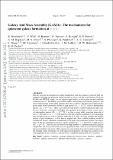Files in this item
Galaxy And Mass Assembly (GAMA) : the mechanisms for quiescent galaxy formation at z < 1
Item metadata
| dc.contributor.author | Rowlands, K. | |
| dc.contributor.author | Wild, V. | |
| dc.contributor.author | Bourne, N. | |
| dc.contributor.author | Bremer, M. | |
| dc.contributor.author | Brough, S. | |
| dc.contributor.author | Driver, S. P. | |
| dc.contributor.author | Hopkins, A. M. | |
| dc.contributor.author | Owers, M. S. | |
| dc.contributor.author | Phillipps, S. | |
| dc.contributor.author | Pimbblet, K. | |
| dc.contributor.author | Sansom, A. E. | |
| dc.contributor.author | Wang, L. | |
| dc.contributor.author | Alpaslan, M. | |
| dc.contributor.author | Bland-Hawthorn, J. | |
| dc.contributor.author | Colless, M. | |
| dc.contributor.author | Holwerda, B. W. | |
| dc.contributor.author | Taylor, E. N. | |
| dc.date.accessioned | 2017-10-20T16:30:21Z | |
| dc.date.available | 2017-10-20T16:30:21Z | |
| dc.date.issued | 2018-01-01 | |
| dc.identifier | 250890764 | |
| dc.identifier | 0da60494-af35-44de-aab1-768393093983 | |
| dc.identifier | 85041893415 | |
| dc.identifier | 000415653600088 | |
| dc.identifier.citation | Rowlands , K , Wild , V , Bourne , N , Bremer , M , Brough , S , Driver , S P , Hopkins , A M , Owers , M S , Phillipps , S , Pimbblet , K , Sansom , A E , Wang , L , Alpaslan , M , Bland-Hawthorn , J , Colless , M , Holwerda , B W & Taylor , E N 2018 , ' Galaxy And Mass Assembly (GAMA) : the mechanisms for quiescent galaxy formation at z < 1 ' , Monthly Notices of the Royal Astronomical Society , vol. 473 , no. 1 , pp. 1168-1185 . https://doi.org/10.1093/mnras/stx1903 | en |
| dc.identifier.issn | 0035-8711 | |
| dc.identifier.other | BibCode: 2017arXiv170707989R | |
| dc.identifier.uri | https://hdl.handle.net/10023/11897 | |
| dc.description.abstract | One key problem in astrophysics is understanding how and why galaxies switch off their star formation, building the quiescent population that we observe in the local Universe. From the GAMA and VIPERS surveys, we use spectroscopic indices to select quiescent and candidate transition galaxies. We identify potentially rapidly transitioning post-starburst galaxies, and slower transitioning green-valley galaxies. Over the last 8 Gyrs the quiescent population has grown more slowly in number density at high masses (M∗>1011M⊙) than at intermediate masses (M∗>1010.6M⊙). There is evolution in both the post-starburst and green valley stellar mass functions, consistent with higher mass galaxies quenching at earlier cosmic times. At intermediate masses (M∗>1010.6M⊙) we find a green valley transition timescale of 2.6 Gyr. Alternatively, at z∼0.7 the entire growth rate could be explained by fast-quenching post-starburst galaxies, with a visibility timescale of 0.5 Gyr. At lower redshift, the number density of post-starbursts is so low that an unphysically short visibility window would be required for them to contribute significantly to the quiescent population growth. The importance of the fast-quenching route may rapidly diminish at z<1. However, at high masses (M∗>1011M⊙), there is tension between the large number of candidate transition galaxies compared to the slow growth of the quiescent population. This could be resolved if not all high mass post-starburst and green-valley galaxies are transitioning from star-forming to quiescent, for example if they rejuvenate out of the quiescent population following the accretion of gas and triggering of star formation, or if they fail to completely quench their star formation. | |
| dc.format.extent | 1097987 | |
| dc.language.iso | eng | |
| dc.relation.ispartof | Monthly Notices of the Royal Astronomical Society | en |
| dc.subject | Galaxies: evolution | en |
| dc.subject | Galaxies: luminosity function, mass function | en |
| dc.subject | Galaxies: starburst | en |
| dc.subject | Galaxies: interactions | en |
| dc.subject | Galaxies: star fomation | en |
| dc.subject | Galaxies: statistics | en |
| dc.subject | QB Astronomy | en |
| dc.subject | QC Physics | en |
| dc.subject | 3rd-DAS | en |
| dc.subject.lcc | QB | en |
| dc.subject.lcc | QC | en |
| dc.title | Galaxy And Mass Assembly (GAMA) : the mechanisms for quiescent galaxy formation at z < 1 | en |
| dc.type | Journal article | en |
| dc.contributor.sponsor | European Research Council | en |
| dc.contributor.institution | University of St Andrews. School of Physics and Astronomy | en |
| dc.identifier.doi | 10.1093/mnras/stx1903 | |
| dc.description.status | Peer reviewed | en |
| dc.identifier.url | http://adsabs.harvard.edu/abs/2017arXiv170707989R | en |
| dc.identifier.grantnumber | ERC-2012-StG-20111012 | en |
This item appears in the following Collection(s)
Items in the St Andrews Research Repository are protected by copyright, with all rights reserved, unless otherwise indicated.

